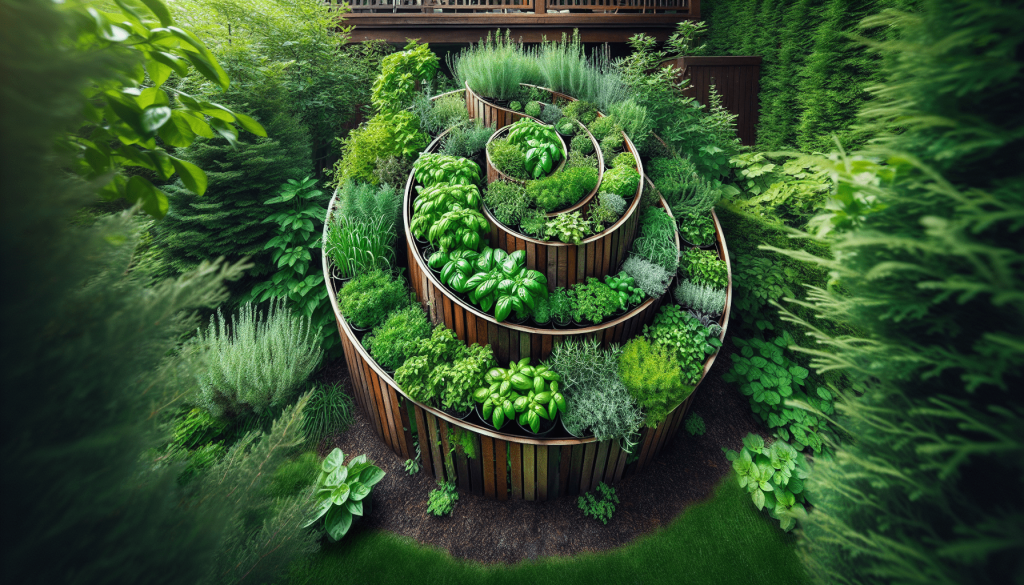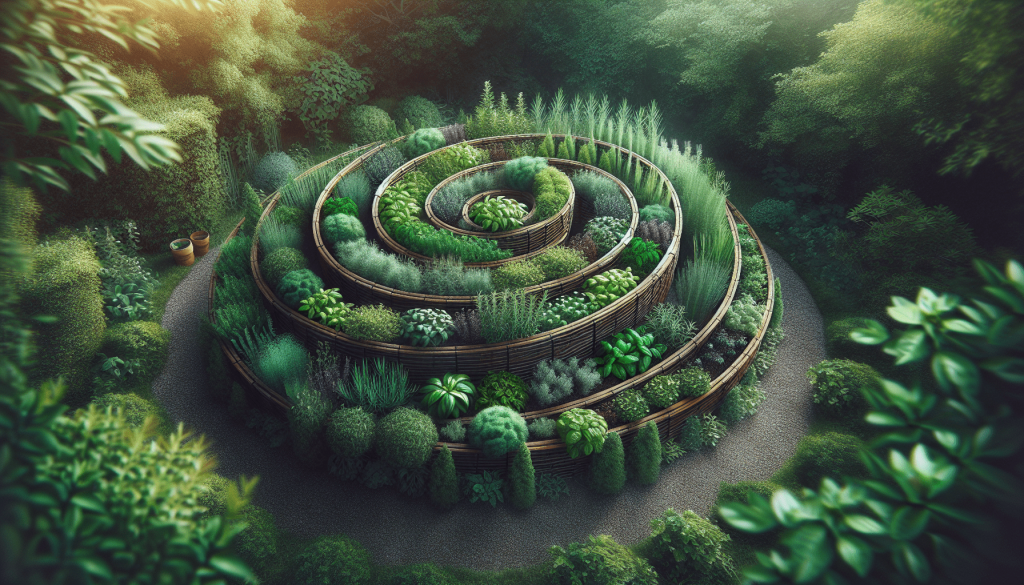This post may contain affiliate links. As an Amazon Associate, we may earn commissions from qualifying purchases.
Creating your very own herb spiral garden can be a fun and rewarding project that brings fresh herbs right to your doorstep. In this guide, “What Are The Steps To Creating A Herb Spiral Garden?”, you’ll discover the step-by-step process to transform a simple piece of garden into a lush, spiraling herb paradise. From selecting the perfect location and design, gathering necessary materials, to planting and maintaining your herbs, you’ll find everything you need to create a stunning, space-efficient garden that thrives year-round. Let’s dive into the exciting journey of building your herb spiral garden together! Have you ever wondered how to create a herb spiral garden that can be both practical and visually appealing? Picture this: a lush, winding garden that condenses a variety of plants into a compact space, making it an eco-friendly and space-saving feature for your yard. A herb spiral garden is not just efficient; it’s an eye-catching way to grow your herbs.
So, let’s dive into the steps to create your herb spiral garden. By breaking down the process, you’ll see that it’s not just for expert gardeners but for anyone who’s ever tried—or even thought about trying—to grow a potted basil plant.

Step 1: Planning Your Herb Spiral Garden
Before you dig into the dirt, let’s talk about the planning phase. Planning might sound boring, but it’s crucial for making sure your herb spiral garden doesn’t end up looking like a scene from a Mad Max movie.
Finding the Perfect Location
You need to pick a prime spot in your yard. Herb spiral gardens love the sun just about as much as cats love knocking things off tables. Ideally, you’ll choose a place that gets a good amount of sunlight—at least 6 hours of it daily. But hey, if shade is the actor in this script, you can still grow some shade-tolerant herbs like mint and parsley.
Measuring Your Space
Get out that rusty old tape measure or the ruler that’s been sitting in your junk drawer forever. Measure the area where you plan to build your herb spiral. A diameter of around 6 feet is usually perfect, but if you’re space-challenged, you can go smaller. Write those numbers down; you’ll want them later.
Deciding on the Herb Types
What herbs are you planning to grow? Are you a fan of spicy dishes and want some cilantro, or do you dream of sipping mint juleps in your backyard? Make a list of the herbs you love. This isn’t just some “somewhere over the rainbow” exercise; different herbs have different needs, and knowing what you want will make the next steps easier.
Step 2: Gathering Your Materials
Now that you’ve pinpointed where and what, let’s talk about how. You’ll need to gather some materials. Consider this your herb spiral garden shopping list.
Soil and Compost
You’re going to need good-quality soil and compost. Your herbs deserve better than the rocky, dry soil that’s been in your yard since the Ice Age. Grab some nutrient-rich compost or prepare it yourself if you’re feeling particularly green-thumbed.
Rocks or Bricks
This is where things get architectural. You’ll need rocks, bricks, or any other sturdy material to create the spiral structure. You’re essentially building the Eiffel Tower for herbs. Large stones, old bricks, or even recycled bottles can work. The key is stability.
Tools and Equipment
Let’s not forget the basic garden tools that will make this project far easier. Shovels, gloves, a wheelbarrow—these are the items you’ll be whispering sweet nothings to by the end of this project. Make sure they’re on-hand and in good condition.
| Materials | Quantity | Notes |
|---|---|---|
| Good-quality soil | Enough to fill your spiral | Check your measurements |
| Compost | 1-2 bags or homemade | Enriches the soil |
| Rocks/Bricks | Enough to create a 6-foot spiral | Gather extra, just in case |
| Shovel | 1 | You probably have this |
| Gloves | 1 pair | Save your hands! |
| Wheelbarrow | 1 | Optional but helpful |
Step 3: Laying the Foundation
You’ve gathered everything you need, and now comes the fun part. It’s time to lay the foundation. If you’ve ever built a sandcastle, you’re halfway there. But remember, this one’s for the ages (or at least for the next couple of years).
Preparing the Ground
Clear the area of debris, grass, and weeds. We don’t want any unauthorized plants crashing this party. Use your shovel to dig down a few inches to make sure the base is flat. Now, lay down some cardboard or landscape fabric to keep those pesky weeds from making a comeback.
Marking the Spiral
Take a long piece of rope or a garden hose and lay it on the ground to outline your spiral. Start from the center and work your way outwards. Ensure the spiral’s widest part is where you’ll grow herb sunbathers like rosemary and thyme. The narrower and more shaded part of the spiral will host your shade-loving guests.
Step 4: Building Up the Spiral
Alright, we’ve got our plan, our materials, and our foundation. This is the part where you channel your inner Bob the Builder and start stacking.
Creating the Spiral Structure
Start stacking your rocks or bricks from the center and work outward, making the edges higher as you go. Each spiral revolution should raise the height slightly, creating a slope that will help with water drainage. Ensure the structure is stable; use smaller stones to fill gaps and secure larger rocks.
Filling with Soil and Compost
Now, fill the spiral with a mixture of soil and compost. Start at the top and work your way down, leaving enough space for planting your herbs. Make sure the soil is evenly distributed so that each herb gets its fair share of nutrients.

Step 5: Planting Your Herbs
The stage is set, the seats are filled, and it’s time to bring out the stars of the show—your herbs.
Selecting Herb Placement
Before you plant, think about the sun and water requirements for each herb. Here’s a handy table to guide you:
| Herb | Sun Requirement | Water Requirement |
|---|---|---|
| Rosemary | Full sun | Drought-tolerant |
| Thyme | Full sun | Drought-tolerant |
| Basil | Full sun | Regular watering |
| Mint | Partial shade | Moist soil (but not soggy) |
| Parsley | Partial shade | Moist soil |
| Cilantro | Full sun | Regular watering |
Plant the sun-lovers at the top of the spiral where it’s the highest and gets the most light. Place the herbs that prefer partial shade toward the bottom.
Planting Process
Make small holes in the soil, just large enough for the root ball of each herb. Place your herb plants into these holes and cover the roots securely with soil. Give each plant a gentle pat to ensure it’s snugly situated. Repeat for all your herbs.
Step 6: Watering and Maintenance
Congratulations, your herb spiral garden is now complete! But just like any great work of art, maintenance is key.
Watering
Your first major task is to water your new garden thoroughly. Make sure the water reaches the roots. With a herb spiral garden, you’ll generally water from the top and let gravity do the work. However, always check the moisture level of the soil and adjust your watering schedule as needed.
Pruning and Harvesting
Your herbs will need regular pruning to stay healthy. Harvest them frequently to encourage new growth, and pinch off any flowers to keep the plants from becoming leggy.
Step 7: Enjoying Your Herb Spiral Garden
All your hard work has paid off! Now, it’s time to kick back and enjoy the fruits (or rather, the herbs) of your labor.
Cooking and Medicinal Uses
There’s something delightful about walking into your backyard to pick fresh herbs for your cooking. Whether you’re making a tangy chimichurri sauce or a refreshing mint tea, the flavors are unmatched. Plus, many herbs like lavender and chamomile have medicinal properties that can soothe a variety of ailments.
Watching It Grow
An added benefit of a herb spiral garden is that it’s a conversation starter. Trust me, it’s way more interesting than your great-uncle’s latest conspiracy theory. Watching your garden flourish over the seasons will give you a sense of accomplishment. It’s as if you’ve created your little ecosystem.
Troubleshooting Common Issues
Even the best scenarios can hit a snag. Here are a few tips to keep your herb spiral garden thriving:
Pests
If pests start crashing your herb party, there are organic options to handle them. Neem oil is a great natural pesticide, and planting companion plants like marigolds can also deter unwanted guests.
Overwatering
It’s easy to get overzealous with watering. Check the soil before adding more water. If it feels damp an inch below the surface, hold off for a while.
Final Thoughts
Creating a herb spiral garden is a gratifying project that offers both aesthetic and practical benefits. It might seem daunting at first, but by breaking it down step by step, you’ll see that it’s entirely doable. Remember, gardening is all about learning and growing—pun intended.
By now, you should have a robust plan to build your own herb spiral garden. Grab that shovel, roll up your sleeves, and let’s turn that dream herb spiral into a reality. Happy gardening!








